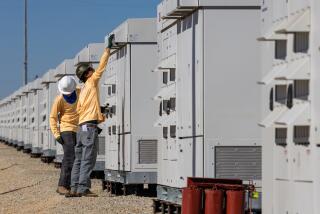Why wind energy has hit a lull in California
Which way is the wind blowing in California?
In some respects, wind energy in the state has never been better, but by other measurements growth has hit a lull for the past four years.
The U.S. Department of Energy released its annual report a few weeks ago analyzing technologies and markets for the wind industry, showing that California has installed 5,656 megawatts of utility-scale wind, the fourth highest in the nation.
California also ranks fifth in capacity for smaller, distributed wind energy systems since 2003, with 66 megawatts.
According to the most recent numbers compiled by the California Energy Commission, wind accounts for 36% of generation from renewable facilities — the most in the state, edging out solar.
One would think those figures would have the state’s leading wind industry group practically giddy.
But instead, Nancy Rader, executive director at the California Wind Energy Assn., was closer to glum when asked about the future of wind energy in the Golden State.
“It’s pretty bleak in terms of the potential for new development,” she said in a telephone interview from her group’s headquarters in Berkeley. “We’re actually at risk of going backward in total capacity in California.”
When wind energy was in its infancy some 30 years ago, California was the sector’s undisputed leader. Thanks in large part to some $1 billion in federal and state taxes, wind farms in California represented more than 90% of the globe’s total wind power capacity in the mid-1980s.
But Texas has taken the lead in the U.S. by a wide margin in total megawatts of wind, with farm states such as Iowa and Kansas moving up fast. Meanwhile, California’s numbers have essentially remained unchanged since 2012.
This year’s Energy Department report showed installed capacity in California was actually 6 megawatts less in 2016 than in 2015.
“No. 4 sounds good until you realize we used to be No. 1, fell to No. 2 and No. 3,” Rader said. “And it keeps going down. And it will continue to go down.”
Rader blames a host of reasons, including land-use restrictions.
California’s desert areas are considered prime spots for wind farms and in the final months of the Obama administration, a plan was finalized that set aside more than 10 million acres for conservation and recreation and designated 388,000 acres for clean energy development, such as solar and wind projects.
Rader said that number is too small, saying about 80% of federal land in the desert is off-limits to wind farms.
At the same time, several counties across the state have issued their own restrictions.
Los Angeles County recently passed a renewable energy ordinance that bans large-scale wind turbines in unincorporated areas.
San Diego County in 2013 adopted rule changes for wind projects, with Rader complaining that an inclusion of a noise restriction is too strict.
Inyo and Solano counties have also put in place restrictions for wind projects.
“We’re facing restrictions like that all around the state,” Rader said. “You can’t put a wind project anywhere. You have to go where there’s good wind, and that’s in really limited areas.”
Resistance to large-scale wind projects may be surprising, given California policymakers’ commitments to reducing greenhouse gas emissions. But pushback also has been seen in a score of states, including Vermont, which also prides itself on clean energy credentials.
Resistance also comes from some residents in rural areas who say wind farms mar views and raise quality of life issues.
“You want to go with renewables but then you get down to the county level and people say it’s a disturbance, it lowers our land value and we don’t want to see it,” said Gary Ackerman, executive director of the Western Power Trading Forum, an organization based in Sacramento whose 90 members in the West buy and sell power.
“It’s fascinating that a state that most people see as the leader in renewable energy development has counties that are saying, not in our backyards, not in our front yards and not in the side yard.”
Environmentalists in general favor wind projects, but some green groups have opposed individual projects.
In San Diego’s East County, construction has begun on the Tule Wind Project in the McCain Valley, but the facility has been opposed by the Protect Our Communities Foundation since plans for the 12,000-acre project were introduced some 13 years ago.
The foundation’s executive director, April Rose Sommer, said her group likes clean energy but believes the Tule project poses a significant danger to birds — golden eagles in particular.
“In this case the damage done to the environment, the damage it does to birds … is not worth what you get out of wind power,” Sommer said.
Tule’s developer, Avangrid Renewables, has long insisted the wind farm will be safe for birds and wildlife.
Another hurdle for wind energy is economic.
Although the Energy Department report highlighted the falling costs of wind energy, natural gas prices have remained low for the past eight years, and falling prices for solar power offer stiff competition.
“Solar power can beat wind power on cost now,” said Bill Powers, a San Diego engineer and consumer advocate. “Why would you pay a premium to build wind turbines in controversial areas when you don’t have to pay that price?”
Patrick Gilman, an Energy Department program manager who helped put together this year’s report, said wind prices are competitive with natural gas when federal tax incentives are included.
He also offered a more optimistic take for the industry in California, saying while capacity has been flat, the amount of wind energy produced in the state has gone up close to 40%.
“Over the past five years, turbines have gotten substantially bigger,” Gilman said. “They’ve gotten substantially cheaper and they capture a lot more energy for the same amount of capacity.”
Growth may also come from beyond California’s borders.
Other states in the West such as Wyoming and New Mexico offer opportunities for California to import lower-priced wind power.
A firm controlled by billionaire Philip Anschutz announced plans to build the nation’s largest wind farm in Wyoming and eventually send the electricity through transmission lines to states such as California, Nevada and Arizona.
Wind farms off the coast of California offer other possibilities.
Offshore wind farms are a common sight in countries such as Denmark, but only one has been constructed in the U.S. and none has been erected on the West Coast, where the continental shelf plunges so steeply that it’s impractical to bolt turbines into the seabed.
A company based in Seattle, Trident Winds, has filed a lease request with the federal government to build a floating array of about 100 wind turbines 33 miles off the coast of Morro Bay.
“Floating offshore wind may have an important role to play,” Gilman said. “The wind resource off the coast of California tends to blow at times when solar is ramping down so there’s a really interesting potential role that technology can play [that is] complementary to solar and land-based wind.”
The plan still has to clear regulatory hurdles and win sufficient backing from locals but Trident Winds hopes to get the project up and running by 2025.
In the meantime, though, California Wind Energy Assn. estimates overall growth in the state to top out at 2,000 additional megawatts in the near-term.
To put that in perspective, just last year Texas by itself added 2,611 megawatts of installed capacity.
“I really think the public needs to reckon with the [land-use] requirements that are going to accompany weaning ourselves from fossil fuels,” Rader said. “I don’t think we’re there yet.”
Installed capacity for wind energy, measured in megawatts, 2016
1. Texas 20,320
2. Iowa 6,911
3. Oklahoma 6,645
4. California 5,656
5. Kansas 4,451
Source: American Wind Energy Assn., U.S. Energy Information Administration
ALSO
California’s goal: an electricity grid moving only clean energy
$3-billion electric vehicle rebate bill moves to California Legislature for full vote
More to Read
Inside the business of entertainment
The Wide Shot brings you news, analysis and insights on everything from streaming wars to production — and what it all means for the future.
You may occasionally receive promotional content from the Los Angeles Times.











